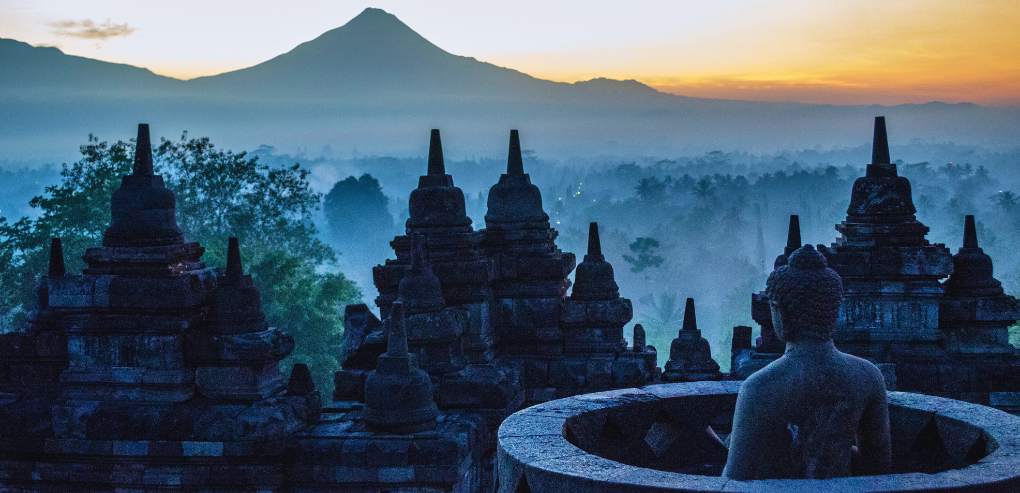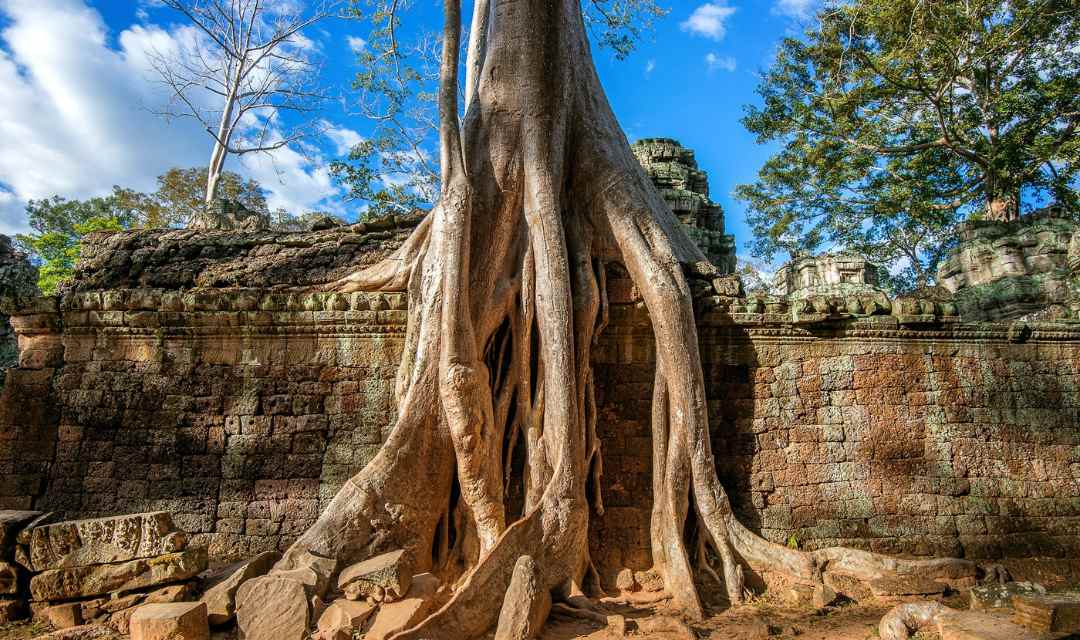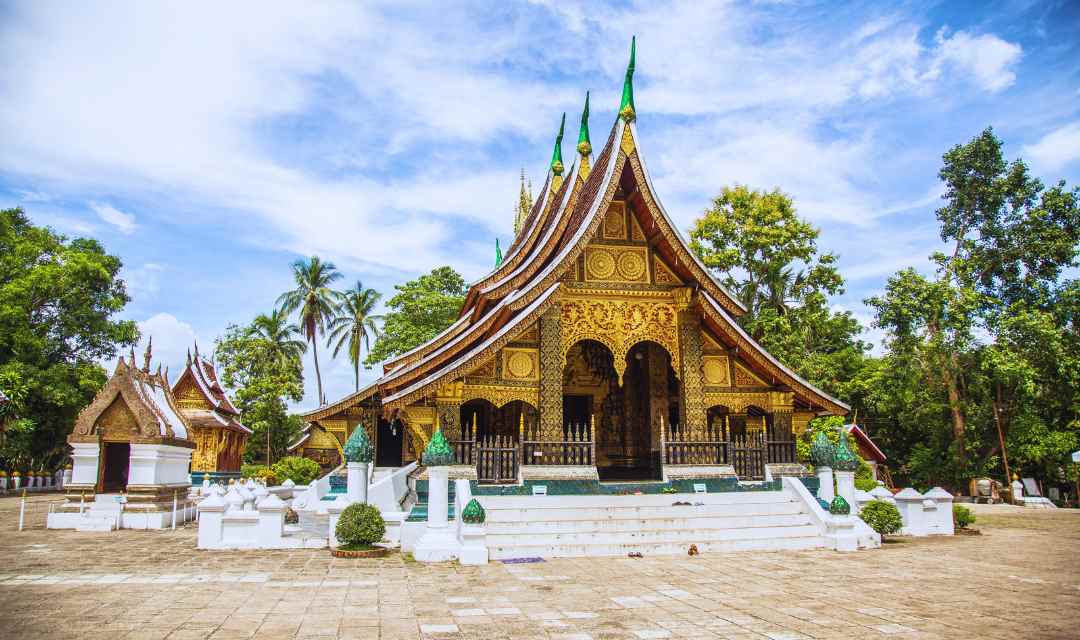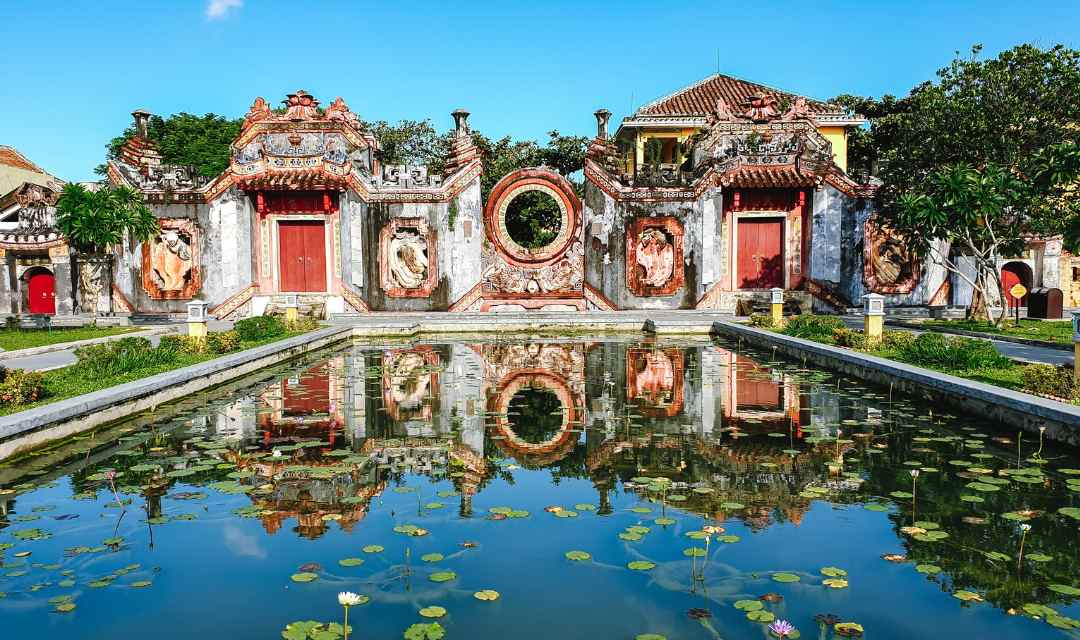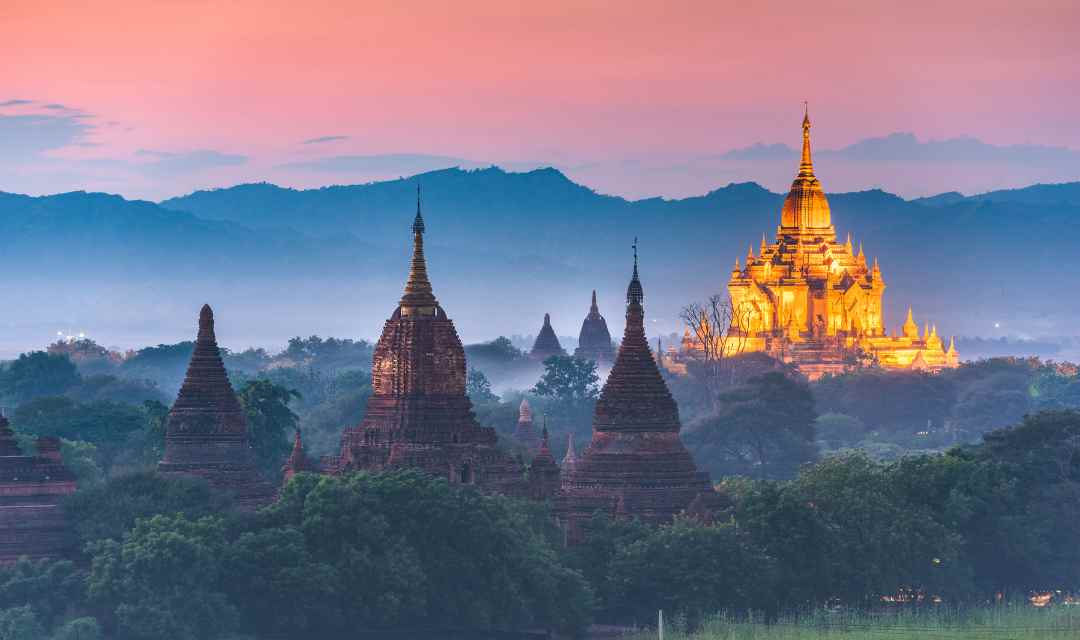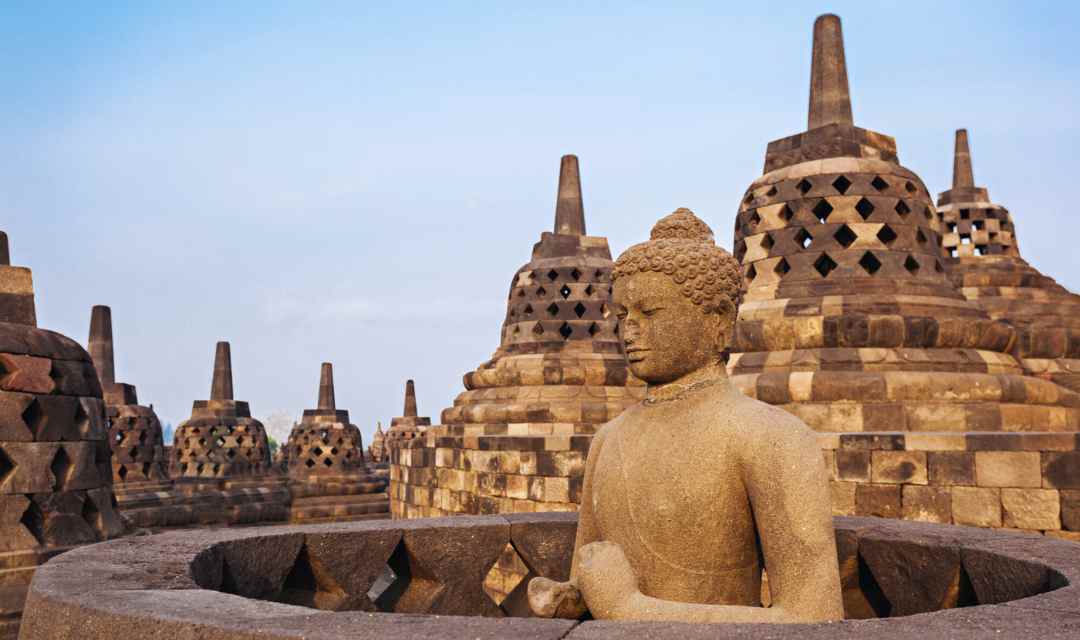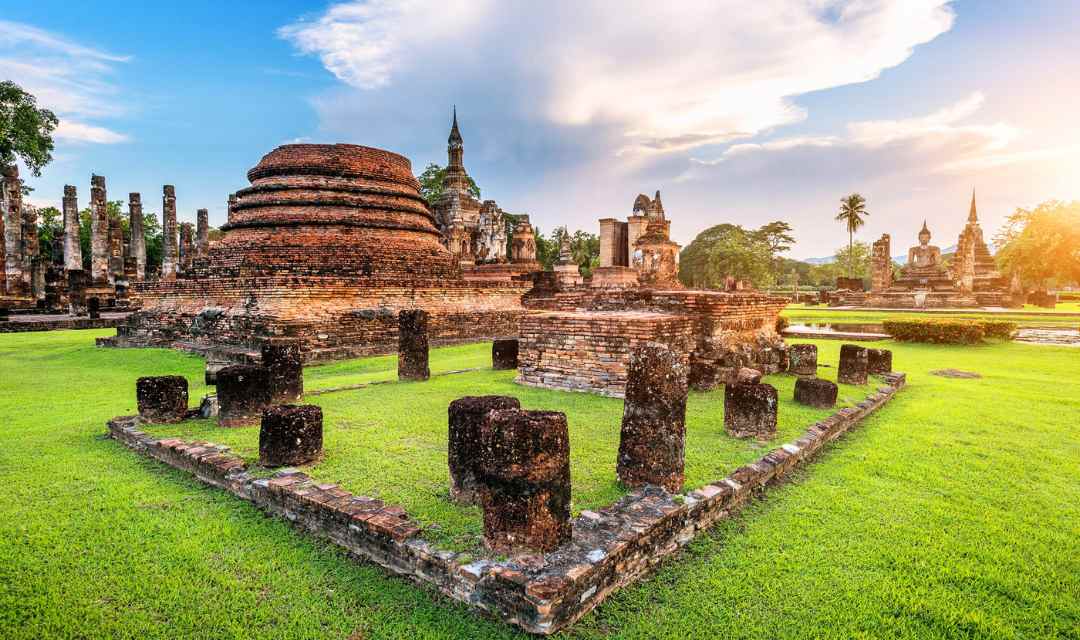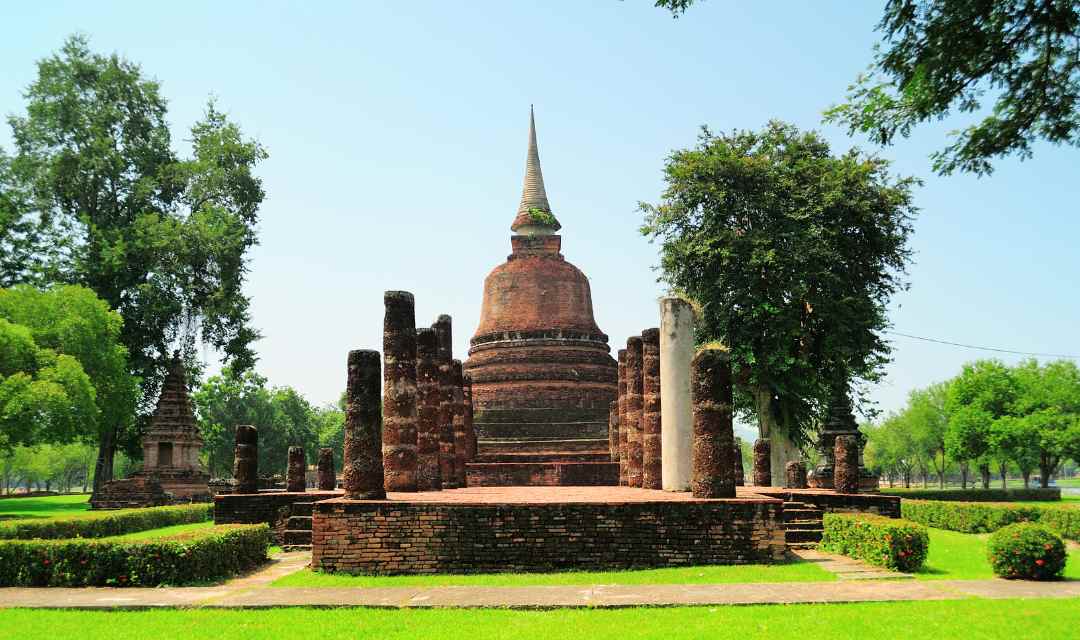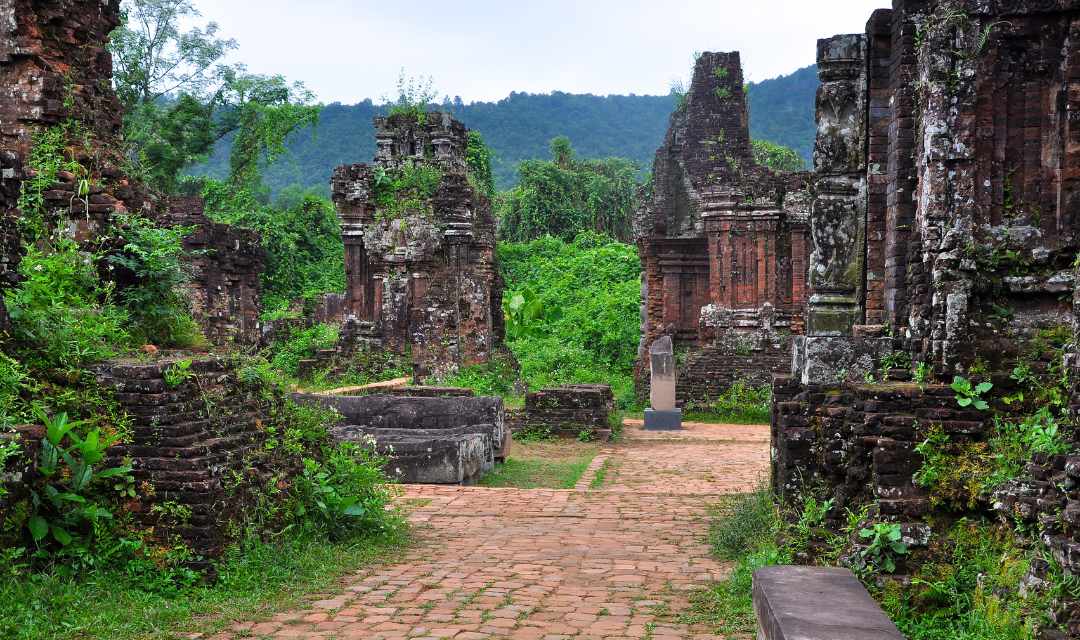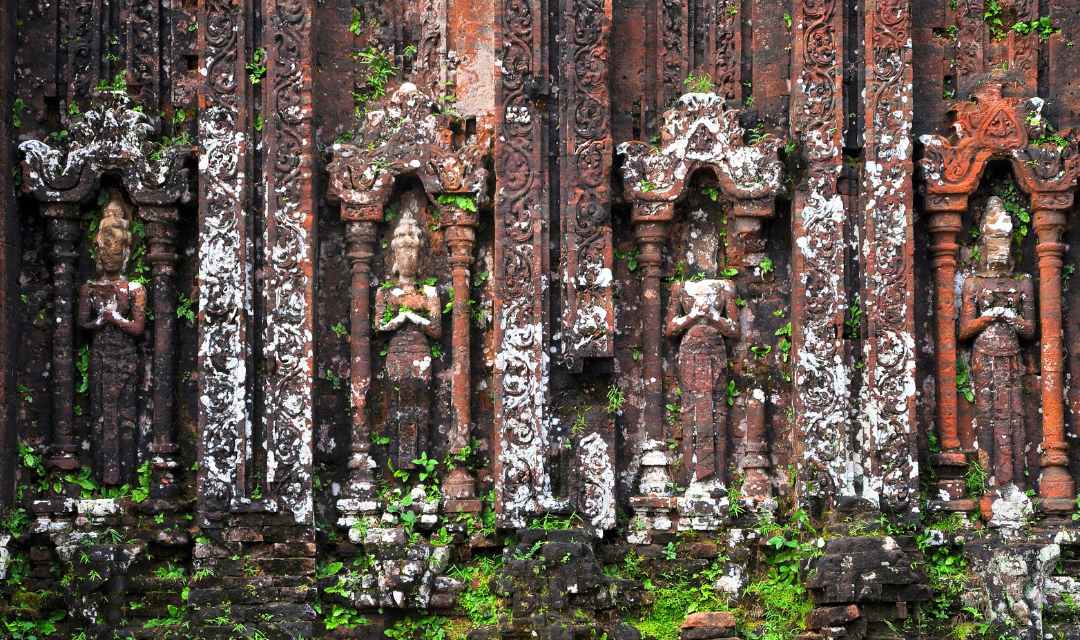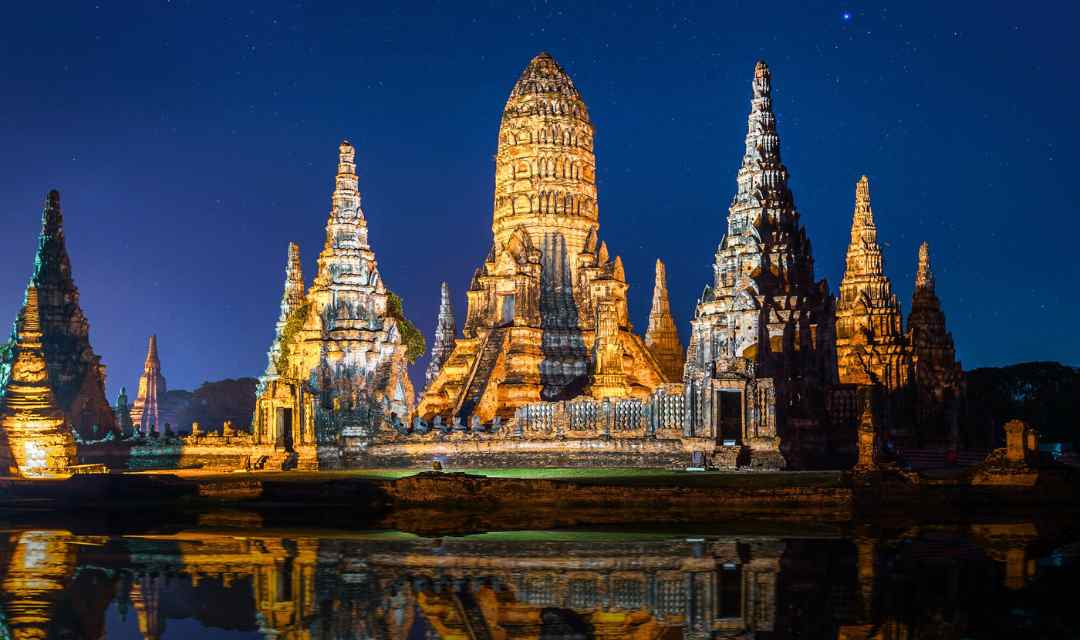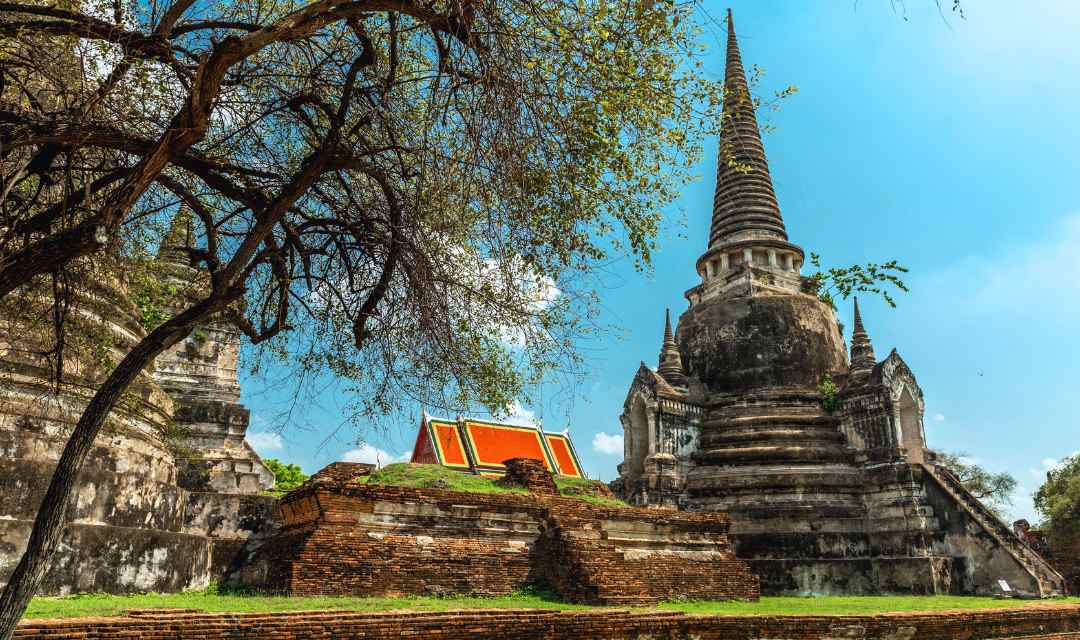Long-Term Travel Tips, Second Brain
Jewels of the Orient – UNESCO World Heritage Towns in Southeast Asia
Towns Of South East Asia That Are UNESCO World Heritage Sites
Are you planning a trip to South East Asia and want to make sure your itinerary includes the most significant UNESCO World Heritage Sites? This region is home to 38 such sites, immersed in rich history and awe-inspiring natural beauty.
Our blog takes you on a journey through these stunning regions, detailing their cultural significance, architectural wonders, and unique attractions. Ready for the adventure of a lifetime? Let’s delve into these mystical towns across Southeast Asia!
Key Takeaways
- Southeast Asia is home to 38 UNESCO World Heritage Sites, including the Angkor Archaeological Park in Cambodia, Luang Prabang in Laos, and Hoi An in Vietnam.
- These towns offer a unique blend of cultural heritage, architectural wonders, and natural beauty.
- Visitors can explore ancient temples, well – preserved colonial architecture, vibrant markets, and breathtaking landscapes throughout these UNESCO sites.
UNESCO World Heritage Sites in Southeast Asia
Southeast Asia has several UNESCO World Heritage Sites, including the Angkor Archaeological Park in Cambodia, Luang Prabang in Laos, and Hoi An in Vietnam.
Angkor Archaeological Park, Cambodia
Rooted in the heart of Cambodia, Angkor Archaeological Park is a legendary testament to Southeast Asia’s rich history. The park boasts magnificent remnants of the Khmer Empire, which shaped regional development from the 9th to 15th centuries.
Among its iconic landmarks is the ancient temple complex Angkor Wat; an awe-inspiring spectacle marrying spiritual devotion with architectural prowess, and one of South East Asia’s most famous UNESCO World Heritage Sites.
Beyond these epic stone walls sprawls a labyrinth of lesser-known temples and structures embedded amidst lush jungle canopy– each bearing their unique aesthetic charm and historical tale.
Herein lies an invitation to immerse yourself in an intriguing journey through time as you explore this cultural sanctuary that served as pivotal cradle for civilization in Southeast Asia.
Angkor Archaeological Park, Cambodia
Dreams forged within sandstone await your discovery at Angkor Archaeological Park, a cornerstone of humanity’s treasured heritage.
Luang Prabang, Laos
Luang Prabang, located in Laos, is a captivating town that has earned its status as a UNESCO World Heritage Site. Known for its well-preserved French colonial architecture and Buddhist temples, it offers a unique blend of cultural heritage and natural beauty.
The town’s charming streets are lined with traditional wooden houses and vibrant markets where you can immerse yourself in the local culture. Explore the exquisite Buddhist temples, including Wat Xieng Thong and Wat Mai Suwannaphumaham, which showcase intricate carvings and stunning murals.
Take a stroll along the Mekong River at sunset to witness breathtaking views of monks in orange robes going about their daily rituals. Luang Prabang truly captures the essence of Southeast Asian charm and provides an enriching experience for any traveler seeking history, spirituality, and tranquility amidst picturesque surroundings.
Hoi An, Vietnam
Hoi An, Vietnam is a captivating UNESCO World Heritage Site that transports visitors back in time. This ancient town is renowned for its well-preserved architecture and rich history, reflecting the influences of various cultures from Chinese and Japanese to European traders.
As you wander through the narrow streets adorned with colorful lanterns, you’ll be awestruck by the charming old houses, ornate temples, and bustling local markets. Don’t miss the iconic Japanese Covered Bridge or the centuries-old merchant houses that offer a glimpse into Hoi An’s prosperous past.
With its vibrant cultural scene and delectable cuisine, Hoi An truly deserves its place as one of Southeast Asia’s must-visit destinations.
Bagan Archaeological Zone, Myanmar
Located in Myanmar, the Bagan Archaeological Zone is a must-visit for history enthusiasts. This UNESCO World Heritage Site is home to over 3,000 ancient temples and pagodas which date back to the 9th century.
The site showcases Myanmar’s ancient civilizations’ rich architectural and cultural heritage. As you explore this vast area, you’ll be captivated by these temples’ intricate details and stunning beauty.
Bagan Archaeological Zone, Myanmar
Don’t miss out on catching a panoramic view of the sunrise or sunset from one of the elevated pagodas – it’s an experience you won’t forget!
Borobudur Temple Compounds, Indonesia
In Indonesia, travelers can explore the awe-inspiring Borobudur Temple Compounds, a UNESCO World Heritage Site. This ancient Buddhist monument is considered one of the most significant in the world and attracts visitors from all over.
Dating back to the 8th and 9th centuries, Borobudur showcases intricate stone carvings depicting Buddhist teachings and stories. The temple’s nine stacked platforms lead up to a central dome adorned with bell-shaped stupas housing statues of Buddha.
Borobudur Temple Compounds, Indonesia
As you climb each level, take in breathtaking views of lush landscapes surrounding this architectural wonder. A visit to Borobudur offers a truly immersive cultural experience that will leave you with lasting memories of your journey through Southeast Asia.
Melaka and George Town
The Historic Cities of the Straits of Malacca – Malaysia
Melaka and George Town, Historic Cities of the Straits of Malacca, Malaysia, are two captivating UNESCO World Heritage Sites in Southeast Asia. These cities showcase a rich blend of cultural influences from their history as major trading ports.
Melaka boasts beautifully preserved Dutch architecture, while George Town flaunts stunning British colonial buildings. As you wander through the narrow streets lined with colorful shophouses and immerse yourself in the vibrant atmosphere, you’ll uncover a treasure trove of historical landmarks, such as A Famosa fortress and St.
Paul’s Church in Melaka, Fort Cornwallis, and Cheong Fatt Tze Mansion in George Town. The fusion of Malay, Chinese, Indian, and European cultures is evident in the architectural wonders and through mouthwatering culinary treats that will leave your taste buds begging for more.
Sukhothai Historical Park, Thailand
Sukhothai Historical Park in Thailand is a captivating UNESCO World Heritage Site that should be on every traveler’s itinerary. This ancient city was the capital of the Kingdom of Sukhothai from the 13th to the 15th century and is now home to remarkable ruins and historical sites.
The park covers an expansive area, allowing visitors to explore its impressive temples, royal palaces, and Buddhist sculptures. One of the highlights is Wat Mahathat, a majestic temple with a towering central stupa surrounded by intricately carved Buddha images.
As you wander through this enchanting park, you’ll feel transported back in time as you soak up Sukhothai’s rich history and cultural significance.
The Splendor of Sukhothai Historical Park
Description of the Park’s Location and Landscape
Nestled in the heart of Thailand, the Sukhothai Historical Park is a testament to the country’s rich history and cultural heritage. The park is located in the Sukhothai province, approximately 427 kilometers north of Bangkok. It’s a serene oasis, spread over an area of 70 square kilometers, surrounded by lush greenery and tranquil lotus ponds. The park’s landscape is a harmonious blend of history and nature, where ancient ruins coexist with verdant flora and fauna.
The Architectural Style and Significance of the Ruins
The ruins within the park are a reflection of the classic Sukhothai architectural style. This style is characterized by its simplicity, elegance, and the symbolic representation of Buddhist cosmology. The structures are predominantly made of laterite and bricks, with intricate stucco work depicting various Buddhist motifs.
One of the most significant ruins in the park is the Wat Mahathat. This temple complex was the spiritual center of the Sukhothai kingdom and is a prime example of the architectural grandeur of that era. The main chedi, or stupa, is designed in the lotus-bud style, a characteristic feature of Sukhothai architecture.
| Ruin | Significance |
|---|---|
| Wat Mahathat | The spiritual center of the Sukhothai kingdom |
| Wat Si Chum | Known for its monumental statue of Buddha |
| Wat Sa Si | Famous for its unique location in the middle of a reservoir |
The Unique Features of the Park
The park is home to some unique features that set it apart. The giant Buddha statues, for instance, are a sight to behold. The most iconic of these is the seated Buddha in Wat Si Chum, known as Phra Achana. This colossal statue, measuring nearly 15 meters in height, is one of the largest in Thailand.
The park is also known for its beautiful lotus ponds. These ponds, filled with blooming lotus flowers, add a touch of tranquility to the historic site. They also serve as a habitat for various species of birds, making the park a paradise for nature lovers and bird watchers.
So, why is Sukhothai Historical Park worth your visit? Imagine walking through the remnants of an ancient civilization, amidst towering Buddha statues and blooming lotus ponds, all while learning about Thailand’s rich history. It’s not just a visit; it’s a journey back in time. And who wouldn’t want to embark on such an adventure?
Exploring the Zones of Sukhothai Historical Park
The Sukhothai Historical Park is divided into five zones. Each zone has its unique charm and set of attractions. Let’s embark on a journey through these zones and discover what each one has to offer.
Central Zone: Description and Key Attractions
The Central Zone is the heart of the Sukhothai Historical Park. It houses the most significant structures, including the majestic Wat Mahathat, the spiritual center of the ancient kingdom. This zone is also home to the Royal Palace, a testament to the grandeur of the Sukhothai era.
Key attractions in the Central Zone include:
- Wat Mahathat: The main temple complex with a large lotus-bud chedi surrounded by smaller ones.
- Royal Palace: The political and administrative hub of the ancient kingdom.
- Wat Si Sawai: A Khmer-style temple known for its three prangs (towers).
North Zone: Description and Key Attractions
The North Zone is serene, home to the impressive Wat Si Chum. This temple houses a gigantic seated Buddha image, known as Phra Achana, one of Thailand’s largest.
Key attractions in the North Zone include:
- Wat Si Chum: Known for its monumental Buddha statue.
- Wat Phra Phai Luang: An older temple predating the Sukhothai era.
West Zone: Description and Key Attractions
The West Zone is a haven for nature lovers. It’s less crowded and offers a peaceful atmosphere. The highlight of this zone is Wat Saphan Hin, located on a hill offering panoramic views of the park.
Key attractions in the West Zone include:
- Wat Saphan Hin: Known for its tall standing Buddha image and the stunning views from the hill.
- Wat Phra Bat Noi: A temple known for its Buddha footprint.
East Zone: Description and Key Attractions
The East Zone is where you’ll find the ancient city’s residential areas. It’s home to Wat Chang Lom, a temple known for its unique design with a chedi surrounded by elephant sculptures.
Key attractions in the East Zone include:
- Wat Chang Lom: Known for its elephant-surrounded chedi.
- Wat Traphang Thong: A temple located on an island in the middle of a large reservoir.
South Zone: Description and Key Attractions
The South Zone is the farthest from the park entrance but worth the visit. It’s home to Wat Chedi Chet Thaeo, a temple known for its seven rows of chedis, each with unique stucco designs.
Key attractions in the South Zone include:
- Wat Chedi Chet Thaeo: Known for its seven rows of unique chedis.
- Wat Khao Suwan Khiri: A hilltop temple offering panoramic views of the park.
The UNESCO World Heritage Status
When and Why Sukhothai Historical Park Was Granted This Status
In 1991, the Sukhothai Historical Park was inscribed as a UNESCO World Heritage Site, a testament to its historical, cultural, and architectural significance. But why was it granted this prestigious status? The ruins of Sukhothai, also known as “Dawn of Happiness,” the first capital of Siam that King Ramkhamhaeng established, are located in the park. The art and architecture of Sukhothai inspired generations and played a crucial role in shaping Thailand’s culture and identity.
The Impact of This Status on the Park and the Surrounding Area
The UNESCO World Heritage status has had a profound impact on the park and the surrounding area. It has led to increased global recognition and a surge in tourism. This influx of tourists has boosted the local economy, creating jobs and opportunities for local businesses. Moreover, the status has also led to better conservation efforts to preserve the park’s historical and cultural integrity.
Visiting Sukhothai Historical Park
Best Time to Visit and Why
The best and ideal time to visit Sukhothai Historical Park is between November and February. During these months, the weather is cooler and more comfortable for exploring the vast park. Plus, in November, you can witness the mesmerizing Loy Krathong festival, where thousands of lanterns illuminate the night sky, creating a magical atmosphere.
How to Get There
Getting to Sukhothai Historical Park is part of the adventure. If you’re coming from Bangkok, you can take a flight, a bus, or a train. Flights are the quickest but also the most expensive option. Buses and trains offer a more affordable alternative, with the journey taking approximately 7-8 hours.
From Chiang Mai, you can take a direct bus to Sukhothai, which takes around 5 hours. Alternatively, you can rent a car and drive, giving you the freedom to explore at your own pace.
Entrance Fees and Opening Hours
The park is open daily from 6:30 am to 7:30 pm. The entrance fee is 100 Thai Baht per zone (Central, North, and West), with separate tickets required for each zone. The East and South Zones are free to enter.
Tips for Visitors to Sukhothai Historical Park
Visiting Sukhothai Historical Park is a unique experience, and here are some tips to make your visit even more enjoyable:
- Rent a bike: The park is vast, and the best way to explore it is by renting a bike. It’s not only a fun way to get around, but it also allows you to see more in less time.
- Dress appropriately: Remember, the park is a historical site with religious significance. Dress modestly out of respect for the local culture.
- Stay hydrated: The Thai sun can be intense, especially during the day. Carry a water bottle to stay hydrated.
- Start early: To beat the crowds and the heat, start your exploration early in the morning.
So, are you ready to step back in time?
Preah Vihear Temple, Cambodia
Preah Vihear Temple in Cambodia is a captivating UNESCO World Heritage Site that should not be missed on your Southeast Asia adventure. This majestic temple complex sits atop a cliff, offering breathtaking panoramic views of the surrounding countryside.
With its intricate carvings and impressive architecture, Preah Vihear Temple is an architectural wonder showcasing Cambodia’s rich history and cultural heritage. Dating back to the 9th century, this ancient Hindu temple is dedicated to Lord Shiva and boasts remarkable stone pavilions and galleries.
Its remote location adds to its allure, making it a truly off-the-beaten-path destination for those seeking to explore the hidden gems of Southeast Asia.
My Son, Vietnam
This evocative temple complex, which can be easily visited on a half-day excursion from Da Nang, transports you back in time. Many of the red brick and sandstone temples are devoted to the Hindu god Shiva, who is considered to be the protector of the Champa rulers. This ancient civilisation lived between the 2nd and 17th centuries.
My Son, Vietnam – a name that evokes images of ancient temples nestled amidst lush jungle valleys. But what is it that makes this place so special? Why does it draw visitors from all corners of the globe? Well, it’s not just a UNESCO World Heritage Site, but a testament to a civilization that once flourished in this part of the world.
My Son Historical Background: The story of My Son begins with the ancient Cham Empire. This powerful kingdom, known for its artistic prowess and maritime strength, left an indelible mark on Southeast Asia. The temples of My Son are a testament to their architectural genius and spiritual devotion.
Constructed between the 4th and 14th century, these temples have weathered the sands of time, standing as silent witnesses to the ebb and flow of history. They are not just stone and mortar structures, but a significant chapter in the rich tapestry of Vietnam’s history.
My Son Architectural Marvel: The temples of My Son are a marvel of ancient architecture. Influenced by Indian architectural styles, they showcase the artistic brilliance of the Cham people. Intricate carvings, towering spires, and stone deities – each element tells its own story.
But it’s not just the physical structures that captivate the visitors. It’s the spiritual significance they hold. These temples were dedicated to Shiva, the Hindu deity, symbolizing the Cham people’s deep-rooted spiritual beliefs.
My Son Natural Setting: Imagine a place where ancient temples peek through a lush jungle canopy, where the Cat’s Tooth Mountain silhouette looms in the distance, and the sound of gurgling streams adds to the mystical ambiance. That’s My Son for you – a place where nature and history blend seamlessly.
The Ruins and Restoration: Time, however, has not been kind to these ancient structures. Wars and natural elements have left their mark, turning many of these architectural marvels into ruins.
But all is not lost. Efforts are underway to restore and preserve these symbols of a bygone era, though the task is fraught with challenges.
Visiting My Son: So, when is the best time to visit My Son? Early morning, when the first rays of the sun light up the ancient structures, is ideal. Getting there is easy, with several transportation options available from major cities.
And what can you expect during your visit?
A journey back in time, a glimpse into an ancient civilization, and an experience that will stay with you long after you’ve left.
My Son – The Cultural Experience: My Son is not just about ancient temples. It’s about experiencing a culture that has withstood the test of time. From local customs and traditions to events and festivals – every aspect offers a glimpse into the rich cultural tapestry of this region.
For a more immersive experience, consider taking a guided tour. Websites like Tourvado offer various options catering to different interests and budgets.
Lenggong Valley Archaeological Site, Malaysia
Lenggong Valley Archaeological Site in Malaysia is a treasure trove for history enthusiasts. This UNESCO World Heritage Site has provided valuable insights into human evolution and cultural development dating back over 1.8 million years! What makes this site truly remarkable is the discovery of the oldest known human-made tools, evidence of early human settlements, and ancient cave paintings.
Immerse yourself in the rich heritage and explore the fascinating remains of past civilizations at Lenggong Valley Archaeological Site.
Some of Southeast Asia’s most captivating UNESCO World Heritage Sites include Ayutthaya Historical Park in Thailand, Melaka and George Town in Malaysia, and Vigan in the Philippines.
Discover their rich history and architectural wonders that will transport you back in time. Read More.
Ayutthaya Historical Park, Thailand
Ayutthaya Historical Park in Thailand is a must-visit destination for history enthusiasts. Located just north of Bangkok, this UNESCO World Heritage Site was once the capital of the Kingdom of Ayutthaya, which ruled over Siam from the 14th to 18th centuries.
Today, visitors can explore the ruins of this ancient city, where grand palaces, magnificent temples, and towering Buddhist statues still stand as a testament to its former glory.
Wandering through Ayutthaya Historical Park feels like stepping back in time. You’ll be awestruck by the intricate architecture and detailed carvings that adorn these historic structures.
One particularly iconic sight is Wat Mahathat’s famous Buddha head entwined in tree roots—a captivating image that has become an emblem of Ayutthaya.
To make your visit even more memorable, consider taking a boat tour along the Chao Phraya River to get a different perspective on this enchanting site. As you cruise past ancient temples and crumbling walls, you’ll gain insight into Ayutthaya’s rich history and cultural significance.
Private Tour of Ayutthaya Historical Park – Bangkok to Ayutthaya Summer Palace by Road
The Temples of Ayutthaya Historical Park
Wat Mahathat – The Great Relic Temple
Have you ever seen a Buddha head entwined in tree roots? That’s the iconic image of Wat Mahathat, the Temple of the Great Relic. This temple, once the heart of the Ayutthaya Kingdom, is now a hauntingly beautiful ruin. It’s a testament to the grandeur of the past and the impermanence of all things. The temple’s central prang (tower) collapsed long ago, but the remaining Buddha statues and stupas still inspire awe. And don’t forget to check out the Ayutthaya tours that include a visit to this historical marvel.
Wat Chaiwatthanaram – The Impressive Royal Temple
Imagine a temple that mirrors the cosmic Mount Meru, the center of the universe in Buddhist cosmology. That’s Wat Chaiwatthanaram, an architectural masterpiece on the banks of the Chao Phraya River. Four smaller prangs surround its central prang, which stands in for the four continents circling the cosmic ocean. The temple’s symmetry and grandeur are a sight to behold, especially at sunset. Want to experience it yourself? Check out the Ayutthaya tours that offer sunset trips to Wat Chaiwatthanaram.
Wat Phra Si Sanphet – Si Sanphet Buddha Temple
Ever wondered where the Emerald Buddha in Bangkok’s Grand Palace originally came from? The answer is Wat Phra Si Sanphet, the holiest temple in the ancient Ayutthaya Kingdom. Although the original Buddha statue is no longer there, the three large stupas housing the ashes of Ayutthaya’s kings still stand tall. Walking through the temple grounds, you can almost hear the echoes of the royal ceremonies that once took place here.
Wat Ratchaburana – The Temple of Royal Restoration
Wat Ratchaburana stands as a symbol of restoration and resilience. This temple, which King Boromrachathirat II constructed on the site of his two older brothers’ cremation, has stood the test of time. Its prang, one of the finest in Ayutthaya, houses a crypt with intricate murals that tell tales of ancient Buddhist cosmology. Isn’t it fascinating how art and history intertwine in such places?
Wat Phanan Choeng – The Temple with 19 Meter Tall Buddha Image
Imagine standing in front of a 19-meter tall Buddha image, gazing up at its serene face. That’s what you’ll experience at Wat Phanan Choeng, home to one of the most revered Buddha images in Thailand. The image, known as Luang Pho Tho, is so beloved that devoted worshippers frequently cover it in gold leaf. It’s a sight that will leave you in awe of the deep spirituality that permeates Thailand.
Wat Lokaya Sutha – The Temple of the Earth
At Wat Lokaya Sutha, you’ll find a reclining Buddha statue that’s almost as long as a blue whale! This 42-meter long statue represents the Buddha entering Nirvana and is a sight to behold. The statue, made of bricks and cement, is dressed in a golden robe that shines brilliantly in the sun. It’s a reminder of the Buddha’s teachings and the path to enlightenment.
Wat Yai Chai Mongkhon – The Victory Temple
Last but not least, Wat Yai Chai Mongkhon is a symbol of victory and determination. Built to commemorate King Naresuan’s victory over the Burmese, this temple is known for its large chedi (stupa) and rows of Buddha statues. The peaceful atmosphere here is perfect for reflection and meditation.
Remember, these are not just temples, but stories etched in stone, waiting to be discovered. And if you’re looking for a guided experience, don’t forget to check out the tours available on Tourvado. Happy exploring!
The Royal Palaces of Ayutthaya Historical Park
The Grand Palace or Wang Luang
Ever wondered what it would be like to walk in the footsteps of ancient Thai kings? At the Grand Palace or Wang Luang, you can do just that. This palace was the Ayutthaya kings’ royal residence and the kingdom’s administrative center. Although much of it is in ruins today, you can still get a sense of its past grandeur. The palace complex includes the Royal Chapel, the Royal Hall, and several other buildings, each with its own unique architectural style and historical significance.
Chandra Kasem Palace or Wang Na
Next, let’s take a virtual stroll to the Chandra Kasem Palace or Wang Na. This palace was the residence of the viceroy or the Uparaja, who was often the brother of the king. Today, it houses the Chandra Kasem Museum, where you can see a collection of artifacts from the Ayutthaya period, including weapons, traditional Thai clothing, and a replica of the royal throne.
Wang Lang – The Rear Palace
Finally, there’s the Wang Lang or the Rear Palace, which was another royal residence. Although not much remains of the original structure, it’s still worth a visit for its historical significance.
Foreign Settlements and Trade in Ayutthaya
Ayutthaya wasn’t just a kingdom; it was a global trading hub. The city’s strategic location made it a melting pot of cultures, with traders from Europe, China, India, and the Malay Archipelago.
Ayutthaya’s intensive trade with foreign nations brought wealth and prosperity to the kingdom. It also led to cultural exchanges and the introduction of new technologies, which significantly impacted the kingdom’s development.
Today, you can still see the remains of several settlements built by foreign traders. These include the Dutch settlement with its canal system, the Portuguese settlement with its Catholic churches, and the Japanese settlement with its traditional houses.
Museums in Ayutthaya
If you’re a history buff, you’ll love the museums in Ayutthaya.
Chao Sam Phraya National Museum
The Chao Sam Phraya National Museum houses a vast collection of artifacts from the Ayutthaya period, including gold treasures, Buddha images, and ceremonial objects. It’s a must-visit for anyone interested in Thai history and culture.
Chandra Kasem Museum
As mentioned earlier, the Chandra Kasem Museum is located in the Chandra Kasem Palace. It offers a fascinating glimpse into the royal lifestyle of the Ayutthaya period.
Admission and Opening Hours
The park is open from 8:30 am to 5:00 pm, and the admission fee is 50 Thai Baht per person. Some temples may have additional fees.
Respectful Behavior Towards Images of the Buddha and Active Temples
Remember, Ayutthaya Historical Park is not just a tourist attraction; it’s a place of religious significance for many Thais. So, be respectful towards the images of the Buddha and the active temples. Dress modestly, keep your voice down, and don’t climb on the ancient structures.
Melaka and George Town, Historic Cities of the Straits of Malacca, Malaysia
Melaka and George Town, Historic Cities of the Straits of Malacca in Malaysia, are two captivating UNESCO World Heritage Sites that offer a fascinating glimpse into the region’s rich history.
Melaka, once an important trading port during the 15th-century Malacca Sultanate, boasts a unique blend of Malay, Chinese, and European influences. Visitors can wander through its narrow streets lined with well-preserved colonial buildings and explore historical sites like St.
Paul’s Church and A Famosa fortress. On the other hand, George Town showcases an eclectic mix of architectural styles ranging from British colonial to Chinese shophouses. Its vibrant street art scene adds a modern twist to this cultural melting pot.
Exploring the UNESCO World Heritage Sites in Southeast Asia
Exploring the UNESCO World Heritage Sites in Southeast Asia reveals a rich tapestry of historical and cultural significance, architectural marvels, natural wonders, and unique experiences.
https://www.youtube.com/watch?v=Vwq7e0pmHi0
Historical and cultural significance
The UNESCO World Heritage Sites in Southeast Asia are not just mere tourist attractions; they hold immense historical and cultural significance that showcases the region’s rich heritage.
These sites represent centuries-old civilizations, ancient traditions, and remarkable architectural achievements. For instance, Angkor Archaeological Park in Cambodia is home to the iconic Angkor Wat temple complex, a symbol of Khmer artistry and spirituality.
The well-preserved town of Hoi An in Vietnam serves as a living testament to its prosperous trading past, with its unique fusion of Vietnamese, Chinese, Japanese, and European influences.
Meanwhile, Borobudur Temple Compounds in Indonesia stands as one of the world’s greatest Buddhist monuments dating back to the 9th century. It represents both spiritual devotion and exceptional craftsmanship.
The historical cities of Ayutthaya in Thailand and Melaka and George Town in Malaysia offer glimpses into their respective countries’ colonial pasts through their beautifully preserved relics from different eras.
Architectural marvels
The towns of Southeast Asia are home to an incredible array of architectural marvels that have stood the test of time. From the towering temples of Angkor Wat in Cambodia to the intricate carvings of Borobudur Temple in Indonesia, these UNESCO World Heritage Sites showcase the rich and diverse history of the region.
Explore Hoi An’s ancient town, with its well-preserved mix of Chinese, Japanese, and Vietnamese influences, or wander through Luang Prabang’s colonial architecture and glittering Buddhist temples.
Each site tells a unique story and offers a glimpse into past civilizations’ extraordinary craftsmanship and ingenuity. Witnessing these architectural wonders firsthand is sure to leave you awe-struck as you step back in time and immerse yourself in Southeast Asia’s cultural heritage.
Natural Wonders and Biodiversity
Southeast Asia is blessed with an abundance of natural wonders and incredible biodiversity, making it a haven for nature lovers. From the majestic limestone karsts of Halong Bay in Vietnam to the stunning coral reefs of Tubbataha Reefs Natural Park in the Philippines, countless natural UNESCO World Heritage Sites are waiting to be explored.
Kinabalu Park in Malaysia boasts one of Southeast Asia’s highest peaks, Mount Kinabalu, while Gunung Mulu National Park in Borneo is home to vast cave systems and unique limestone formations.
These exceptional sites showcase the region’s rich ecological diversity and offer visitors unforgettable experiences amidst some of Mother Nature’s most spectacular creations.
Unique experiences and attractions
Southeast Asia is a treasure trove of unique experiences and attractions that will leave you in awe. From exploring the ancient temples at Angkor Archaeological Park in Cambodia to wandering through the well-preserved streets of Hoi An Ancient Town in Vietnam, there is no shortage of cultural wonders to discover.
Marvel at the architectural grandeur of Borobudur Temple in Indonesia or immerse yourself in the natural beauty of Halong Bay with its towering limestone karsts rising from emerald waters.
If you’re seeking adventure, head to Komodo National Park in Indonesia where you can encounter the legendary Komodo dragons up close. Don’t miss out on experiencing these extraordinary sites that make Southeast Asia truly exceptional.
The towns of Southeast Asia that are UNESCO World Heritage Sites offer a captivating glimpse into the region’s rich cultural and historical tapestry. From the awe-inspiring Angkor Wat in Cambodia to the charming ancient town of Hoi An in Vietnam, these sites are architectural marvels and provide unique experiences and attractions for travelers.
FAQs
How many towns in South East Asia are designated as UNESCO World Heritage Sites?
Currently, there are a total of 11 towns in South East Asia that have been recognized as UNESCO World Heritage Sites for their cultural and historical significance.
What criteria must a town meet to become a UNESCO World Heritage Site?
To be considered for designation as a UNESCO World Heritage Site, a town must demonstrate exceptional universal value and meet one or more of the ten selection criteria set by the organization. These criteria include representing a masterpiece of human creative genius, exhibiting an important interchange of values between different cultures, or being associated with events or traditions that have universal significance.
Can you provide examples of towns in South East Asia that are UNESCO World Heritage Sites?
Certainly! Some notable examples include Hoi An Ancient Town in Vietnam, George Town in Malaysia, Luang Prabang in Laos, and Vigan City in the Philippines. Each of these towns possesses unique cultural heritage and architectural beauty that make them worthy of recognition by UNESCO.
What benefits do towns gain from being designated as UNESCO World Heritage Sites?
Designation as a UNESCO World Heritage Site brings several benefits to towns in South East Asia. It enhances international recognition and tourism promotion, attracting more visitors who appreciate cultural heritage sites. This increased tourism can stimulate economic growth through job creation and local development while also raising awareness about the importance of preserving these unique places for future generations.
In conclusion, the UNESCO World Heritage Towns of Southeast Asia are more than just destinations; they are timeless treasures that offer a unique blend of history, culture, and natural beauty. Each town, with its distinct charm and character, paints a vibrant picture of the region’s rich heritage. As we’ve journeyed through these jewels of the Orient, we’ve not only discovered places of breathtaking beauty but also stories that resonate across time. These towns serve as a testament to the resilience, creativity, and spirit of the people of Southeast Asia. So, whether you’re a history buff, a culture enthusiast, or a nature lover, these heritage towns promise an unforgettable journey into the heart of the Orient.

